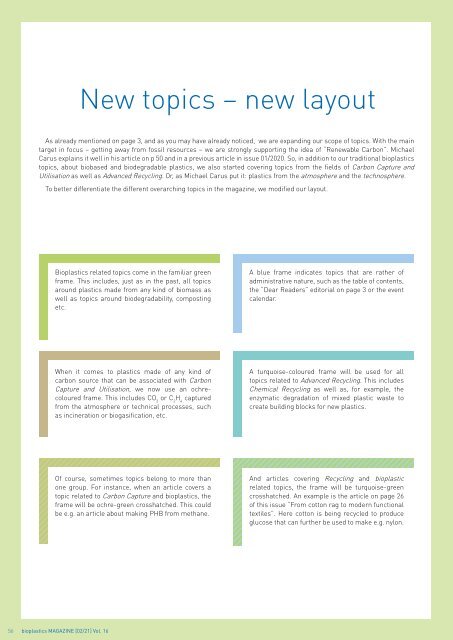issue 02/2021
Highlights: Injection Moulding Basics: Mass Balance
Highlights:
Injection Moulding
Basics: Mass Balance
You also want an ePaper? Increase the reach of your titles
YUMPU automatically turns print PDFs into web optimized ePapers that Google loves.
30 bioplastics MAGAZINE [<strong>02</strong>/21] Vol. 16<br />
New topics – new layout<br />
As already mentioned on page 3, and as you may have already noticed, we are expanding our scope of topics. With the main<br />
target in focus – getting away from fossil resources – we are strongly supporting the idea of “Renewable Carbon”. Michael<br />
Carus explains it well in his article on p 50 and in a previous article in <strong>issue</strong> 01/2<strong>02</strong>0. So, in addition to our traditional bioplastics<br />
topics, about biobased and biodegradable plastics, we also started covering topics from the fields of Carbon Capture and<br />
Utilisation as well as Advanced Recycling. Or, as Michael Carus put it: plastics from the atmosphere and the technosphere.<br />
To better differentiate the different overarching topics in the magazine, we modified our layout.<br />
Bioplastics related topics come in the familiar green<br />
frame. This includes, just as in the past, all topics<br />
around plastics made from any kind of biomass as<br />
well as topics around biodegradability, composting<br />
etc.<br />
A blue frame indicates topics that are rather of<br />
administrative nature, such as the table of contents,<br />
the “Dear Readers” editorial on page 3 or the event<br />
calendar.<br />
When it comes to plastics made of any kind of<br />
carbon source that can be associated with Carbon<br />
Capture and Utilisation, we now use an ochrecoloured<br />
frame. This includes CO 2<br />
or C 2<br />
H 4<br />
captured<br />
from the atmosphere or technical processes, such<br />
as incineration or biogasification, etc.<br />
A turquoise-coloured frame will be used for all<br />
topics related to Advanced Recycling. This includes<br />
Chemical Recycling as well as, for example, the<br />
enzymatic degradation of mixed plastic waste to<br />
create building blocks for new plastics.<br />
Of course, sometimes topics belong to more than<br />
one group. For instance, when an article covers a<br />
topic related to Carbon Capture and bioplastics, the<br />
frame will be ochre-green crosshatched. This could<br />
be e.g. an article about making PHB from methane.<br />
And articles covering Recycling and bioplastic<br />
related topics, the frame will be turquoise-green<br />
crosshatched. An example is the article on page 26<br />
of this <strong>issue</strong> “From cotton rag to modern functional<br />
textiles”. Here cotton is being recycled to produce<br />
glucose that can further be used to make e.g. nylon.<br />
46 bioplastics MAGAZINE [01/21] Vol. 16<br />
30 bioplastics MAGAZINE [<strong>02</strong>/21] Vol. 16 30 bioplastics MAGAZINE [<strong>02</strong>/21] Vol. 16<br />
56 bioplastics MAGAZINE [<strong>02</strong>/21] Vol. 16


















